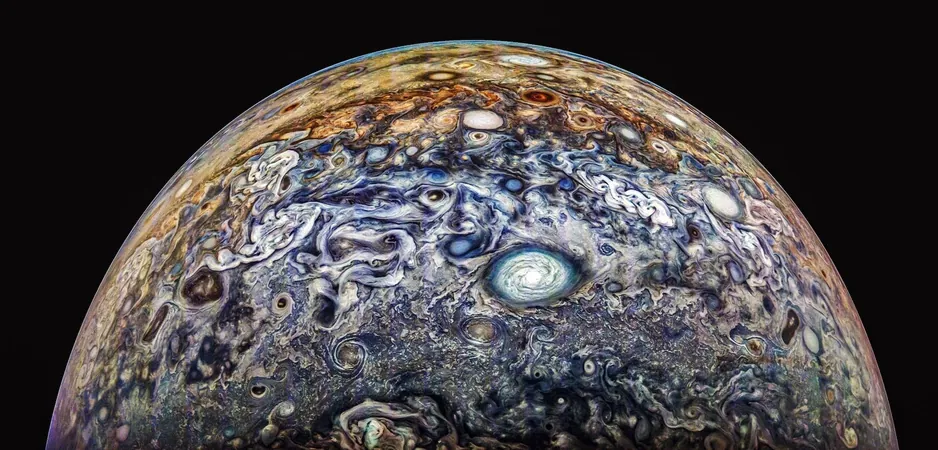
Stunning New Images from NASA's Juno Reveal the Mysteries of Jupiter!
2024-11-05
Author: Jia
NASA's Juno spacecraft has thrilled space enthusiasts once again by delivering breathtaking new images of Jupiter after its 66th close flyby, marking an exciting phase as it enters the final year of its groundbreaking mission. On October 23, 2024, Juno achieved this latest flyby, making it the first spacecraft to pass so closely to the poles of the gas giant.
Since its arrival in July 2016, Juno has been on a remarkable journey, orbiting Jupiter and sending back thousands of high-resolution images that unveil the intricate atmosphere of the planet and highlight its intriguing moons. The latest batch of photos is nothing short of mesmerizing.
In this recent flyby, Juno made a close pass of Amalthea, Jupiter's fifth-largest moon, known for its distinct potato-like shape and a diminutive size, boasting a radius of only 52 miles (or 84 kilometers). To put that into perspective, Amalthea is considerably smaller than Earth's moon and orbits around Jupiter much closer than the more famous moon, Io.
Equipped with a two-megapixel camera known as JunoCam, the spacecraft has been capturing detailed images that reveal Jupiter's dynamic weather patterns, including its striking bands and tumultuous storms. In addition to JunoCam, the spacecraft is loaded with sophisticated scientific instruments, including a magnetometer, a gravity science system, and a microwave radiometer, which together provide invaluable insights into the giant planet.
What is truly remarkable about the Juno mission is its reliance on citizen scientists. The raw image data collected by JunoCam during its high-speed spins around Jupiter is made available to the public, enabling space enthusiasts worldwide to process these images and contribute creatively to the mission. Their contributions have resulted in vibrant and artistic interpretations of Jupiter's atmospheric beauty.
Meanwhile, the mission to explore Jupiter is far from over, as two additional missions are set to follow in Juno's wake. The European Space Agency's JUICE (Jupiter Icy Moons Explorer), launched last year, will capture images of Jupiter's moon Callisto 21 times during its close flybys, ultimately entering orbit around Ganymede for an extended 18-month study period. Additionally, NASA's Europa Clipper, launched just earlier this month, is on a trajectory to reach Jupiter in 2030, aiming to explore the intriguing moon Europa and its potential for harboring life.
Looking ahead, Juno is scheduled for its next close flyby, known as perijove 66, on November 25, 2024. The mission is set to conclude on September 15, 2025, with a dramatic "death dive" into Jupiter's atmosphere during its 76th perijove, ensuring that the spacecraft does not inadvertently collide with one of Jupiter's moons, particularly Europa, which may host conditions suitable for life.
As the Juno mission continues to unfold, space enthusiasts around the globe are encouraged to keep their eyes on the sky, eager to witness the unfolding cosmic masterpiece that is Jupiter. Prepare to be amazed!





 Brasil (PT)
Brasil (PT)
 Canada (EN)
Canada (EN)
 Chile (ES)
Chile (ES)
 España (ES)
España (ES)
 France (FR)
France (FR)
 Hong Kong (EN)
Hong Kong (EN)
 Italia (IT)
Italia (IT)
 日本 (JA)
日本 (JA)
 Magyarország (HU)
Magyarország (HU)
 Norge (NO)
Norge (NO)
 Polska (PL)
Polska (PL)
 Schweiz (DE)
Schweiz (DE)
 Singapore (EN)
Singapore (EN)
 Sverige (SV)
Sverige (SV)
 Suomi (FI)
Suomi (FI)
 Türkiye (TR)
Türkiye (TR)